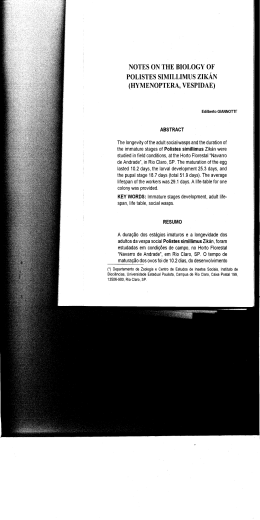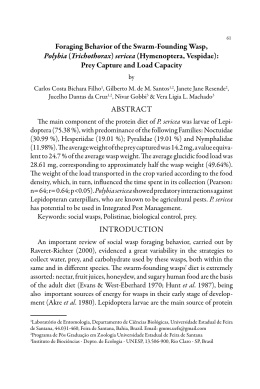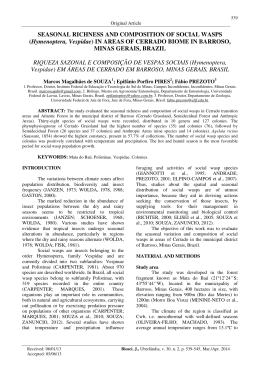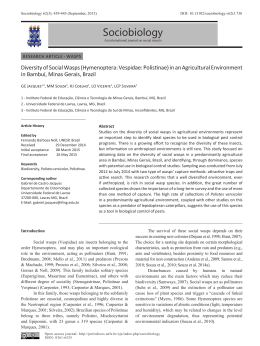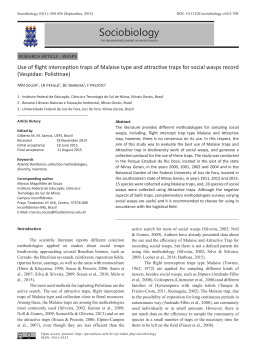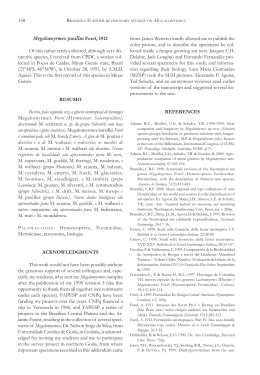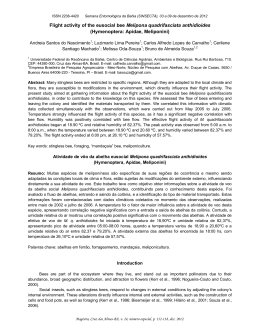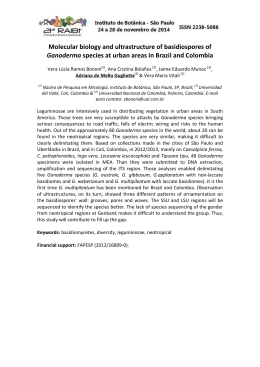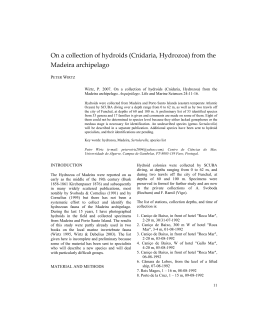Colony cycle of the social wasp Mischocyttarus consimilis Zikán (Hymenoptera, Vespidae) Viviana O. Torres1, Thiago S. Montagna1, Wedson D. Fernandes2 & William F. Antonialli-Junior1 1 Centro Integrado de Análise e Monitoramento Ambiental, Universidade Estadual de Mato Grosso do Sul, 79804–970 Dourados-MS, Brazil. [email protected]; [email protected]; [email protected] 2 Faculdade de Ciências Biológicas e Ambientais, Universidade Federal da Grande Dourados, 79804–970 Dourados-MS, Brazil. [email protected] ABSTRACT. Colony cycle of the social wasp Mischocyttarus consimilis Zikán (Hymenoptera, Vespidae). This study describes some aspects of the colony cycle of the Neotropical social wasp Mischocyttarus consimilis, from data obtained under field conditions. Our results showed that the colony cycle in M. consimilis is annual and asynchronous in relation to the months of the year. The colonies remained active for approximately eight months. Most of the abandonments were associated with natural causes, and were most frequent in the pre-emergence stage. The nests were constructed preferentially in man-made structures, especially in sites protected from direct sunlight and rain. Colony foundation was either by haplometrosis or pleometrosis, being the first form predominant. KEYWORDS. Colony development; natural history; neotropical wasp; phenology; Polistinae. RESUMO. Ciclo colonial da vespa social Mischocyttarus consimilis Zikán (Hymenoptera, Vespidae). Este estudo descreve alguns aspectos do ciclo colonial da vespa social Neotropical Mischocyttarus consimilis, sendo realizado em condições de campo. Os resultados desse estudo mostraram que o ciclo colonial em M. consimilis é anual, bem como assincrônico em relação aos meses do ano. Em geral, as colônias permanecem em atividade por aproximadamente oito meses. Os abandonos de colônia estão associados principalmente a causas naturais, e são mais freqüentes na fase colonial de pré-emergência. Os ninhos são estabelecidos preferencialmente em construções humanas, especialmente em locais protegidos da incidência direta de luz solar e água da chuva. Fundações de colônia ocorrem por uma ou outra forma haplometrose ou pleometrose, sendo a primeira predominante. PALAVRAS-CHAVE. Desenvolvimento colonial; fenologia; história natural; Polistinae; vespa neotropical. In polistine wasps, the periodicity of the foundation and abandonment of colonies differs between species of tropical and temperate climates (Gadagkar 1991; Reeve 1991). In temperate areas, the colony cycle is synchronized with the seasons, beginning in the middle of spring and finishing at the end of autumn or beginning of winter (West-Eberhard 1969). In these conditions there is a period of inactivity that extends from the abandonment of the colonies to the new foundations, during which the wasps hibernate (Yoshikawa 1963). This period is characterized by the formation of aggregations, which are initially constituted by males and later by potentially reproductive females, which after they abandon the maternal nest, migrate to sheltered locations or old abandoned nests (Spradbery 1973). In general, the mating of the potentially reproductive females occurs in their own aggregation, and during the winter (Yoshikawa 1963; Spradbery 1973). In contrast, the colony cycle of social wasps in tropical areas is relatively longer, occasionally more than a year (Giannotti 1997). In these conditions, colonies are founded and abandoned at any time of year (Gobbi & Zucchi 1980). Thus, colonies in different stages of development can occur in the same population in the same period, and this nesting cycle pattern is termed asynchronous (Wilson 1971). How- ever, under adverse climate conditions (e.g., low temperatures in winter), the colony cycle of tropical wasps can be occasionally interrupted, and show characteristics similar to the cycle of temperate wasps (González et al. 2002; TannureNascimento et al. 2005; Gobbi et al. 2006). In polistine wasps, the colonies are founded either independently or swarms form (Jeanne 1980). In independent foundations, one or more foundresses unaccompanied by workers begin a new colony, which can occur either haplometrotic or pleometrotic forms (Gadagkar 1991). Independent-foundation species generally contains few individuals in the colony, and the nests do not possess a covering envelope (Gadagkar 1991). This foundation pattern can be found in four genera of Polistinae (Polistes, Mischocyttarus, Belonogaster, and Parapolybia) and in some species of Ropalidia (Gadagkar 1991). The objective of this study was to describe in detail the colony cycle of the social wasp Mischocyttarus consimilis Zikán, 1949. MATERIAL AND METHODS Study site and climate characterization.The study was conducted under field conditions in an area of approximately two hectares on the campus of the Universidade Federal da Revista Brasileira de Entomologia 55(2): 247–252, junho, 2011 252 Litte, M. 1979. Mischocyttarus flavitarsis in Arizona: Social and nesting biology of a polistine wasp. Zeitschrift für Tierpsychologie 50: 282– 312. O’ Donnell, S. & F. J. Joyce. 2001. Seasonality and colony composition in a montane tropical eusocial wasp. Biotropica 33: 727–732. Penna, M. A. H.; N. Gobbi & H. C. Giacomini. 2007. An evaluation of the productivity of Mischocyttarus drewseni in a semi-urban environment (Hymenoptera: Polistinae). Sociobiology 50: 113–120. Poltronieri, H. S. & V. M. Rodrigues. 1976. Vespídeos sociais: estudos de algumas espécies de Mischocyttarus Saussure, 1853 (Hymenoptera.Vespidae. Polistinae). Dusenia 9: 99–105. Reeve, H. K. 1991. Polistes, p. 99–148. In: K. G. Ross & R. W. Matthews (eds.). The social biology of wasps. Ithaca, Cornell University Press, xvii+678 p. Richards, O. W. 1978. The social wasps of the Americas excluding the Vespinae. London, British Museum (Natural History), vii+580 p. Spradbery, J. P. 1973. Wasps: an account of the biology and natural Received 28/4/2010; accepted 19/4/2011 Editor: Maria Cristina Gaglianone Revista Brasileira de Entomologia 55(2): 247–252, junho, 2011 Torres et al. history of solitary and social wasps. Seattle, University of Washington Press, xvi+408 p. Tannure-Nascimento, I. C.; F. S. Nascimento & R. Zucchi. 2005. Size and colony cycle in Polistes satan, a Neotropical paper wasp (Hymenoptera Vespidae). Ethology Ecology and Evolution 17: 105–119. Tibbetts, E. A. & H. K. Reeve. 2003. Benefits of foundress associations in the paper wasp Polistes dominulus: increased productivity and survival, but no assurance of fitness returns. Behavioral Ecology 14: 510–514. West-Eberhard, M. J. 1969. The social biology of polistine wasps. Miscellaneous Publications, Museum of Zoology, University of Michigan 140: 1–101. Wilson, E. O. 1971. The insect societies. Cambridge, Belknap Press, x+548 p. Yoshikawa, K. 1963. Introductory studies on the life economy of polistine wasps. V. Three stages relating to hibernation. Journal of Biology, Osaka City University 14: 87–96. Zavatini, J. A. 1992. Dinâmica climática no Mato Grosso do Sul. Geografia 17: 65–91.
Download
